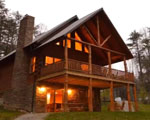STONELICK LAKE STATE PARK
Tucked away in the rolling highlands of southwest Ohio, Stonelick State Park offer a quiet retreat for visitors. The still waters of the lake and stately woodlands provide the setting for a host of outdoor recreational pursuits.
By studying the bedrock layers in Ohio, we can find clues that reveal ancient seas, marshes or swamps covered all or portions of the state at various times in the past. Remains of plants and animals that lived in those waters littered the sea's floor and became entombed as lime precipitated to the bottom. Eventually, the lime and other sediments solidified into stone and uplifted forming dry land.
An arch formed in Ohio, during the time the Appalachian Mountains were formed, known as the Cincinnati Arch. This dome-like feature of uplifted bedrock passes through Stonelick. Several areas of the arch have been exposed from erosion uncovering some of the oldest rocks (350-500 million years old) in Ohio. The once entombed fossils are now exposed giving Stonelick one of the richest fossil records in the state. The rocks of the arch contain so many fossils of such diverse species that they have become very famous and have attracted people from all over the world since the early 1800s. Trilobite, brachiopods and cephalopods provide excellent finds for fossil hunters.
Another interesting feature of the Stonelick landscape is the significant stand of sweet gum trees. Normally, sweet gum is a subordinate tree but co-dominates the woodlands of Stonelick with beech and maple. Substantial colonies of dense flying star, purple fringeless orchid and Virginia mountain mint--all uncommon wildflowers in Ohio--can be found in the park.
Stonelick State Park lies within Clermont County, the eighth county established in the Northwest Territory. Settlement of the area began in 1798 when the towns of Bethel and Williamsburg were laid out. A considerable amount of the early settlers came from Kentucky, Virginia and Pennsylvania.
Several clashes between the settlers and Indians occurred here as the area was situated between the Kentucky settlements south of the Ohio River and the Indian villages along the Little Miami River. Legendary frontiersmen, Daniel Boone and Simon Kenton, were among those involved in the conflicts.
The town of nearby Milford was the site of the first Methodist church in Ohio. Francis McCormick, a pioneer Methodist preacher, organized the church in his cabin.
Clermont County was a vital link in the Underground Railroad as it was just across the river from the "slave owning" states of Kentucky and Virginia. The position of Clermont on the border made it the first place of refuge for fleeing slaves. The county was also the birthplace of Civil War General Ulysses S. Grant at Point Pleasant on the Ohio.
Land acquisition for Stonelick State Park began in 1948. A dam across Stonelick Creek was completed in 1950. This beautiful park was originally created to provide a wildlife area for Ohio's sportsmen. Now the area is operated by the ODNR Division of Parks and Recreation and offers a variety of outdoor recreational activities.
Ohio does not have an annual pass and does not charge entrance fees to state parks.
GeneralLand, acres1,058
Water, acres200
Day-UseFishingyes
Huntingyes
Hiking Trail, miles5
Picnickingyes
Swimming Beach, feet500
Nature Programsyes
BoatingBoat Rentalyes
Boating Limits-1
Launch Ramps, #1
CampingPrimitive, #6
Electric Sites, #109
Pets Permittedyes
Flush Toiletsyes
Dumpstationyes
Showersyes
Camper Cabins, #1
WinterSleddingyes
Cross-Country Skiingyes
Ice Boatingyes
Ice Skatingyes
Ice Fishingyes
There are 115 campsites, 109 with electricity, at Stonelick's main campground. The campground is equipped with showers, flush toilets, dump station and laundry facilities. Pet camping is permitted on designated sites. There is a camp store with items for sale.
A nice public beach provides enjoyment for swimmers and sunbathers on the lake's south shore.
Boats with electric motors only are permitted on Stonelick Lake. Two launch ramps provide access to the lake. Kayak, canoe and paddle board rentals are available.
Stonelick Lake State Park in Ohio offers a variety of fishing options for both experienced and novice anglers. The park's main attraction is the 200-acre Stonelick Lake, which provides ample opportunities to catch different species of fish including largemouth bass, bluegill, crappie, channel catfish and saugeye. Fishing can be done from the shore or by boat with electric motors only allowed on the lake. A valid Ohio fishing license is required.



